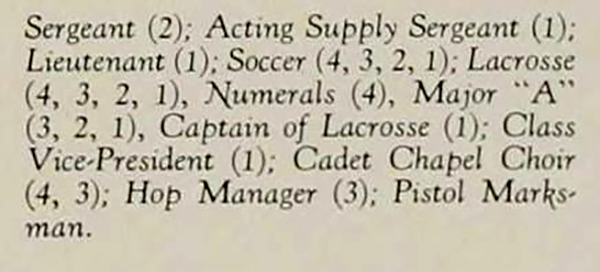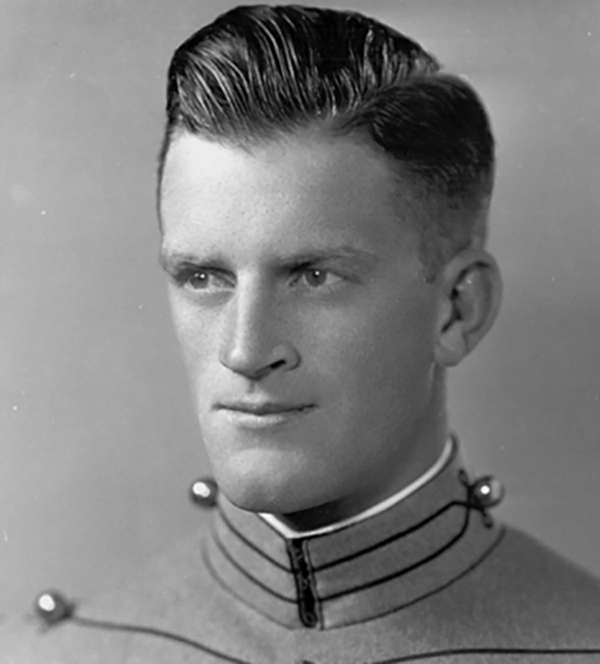
(above) Lt. Col. Thomas Truxtun West Point Year book 1937.
Meet Lieutenant Colonel Thomas Truxtun, Commanding Officer 210th Field Artillery Battalion One of Cranford’s 86
By Don Sweeney
The selection honoring another one of our Cranford war heroes was recently made at the Cranford Public Library. My research mentor, Lieutenant Colonel Steve Glazer (Ret.), of The Cranford Historical Society, conducted a one-on-one training session using the local-history archives available on the library’s website. Steve also showed me the many resources that can be accessed on a computer through such sites as the Cranford Burditt files, Ancestory.com, Findagrave.com, Fold3.com and Newspapers.com. It was an eye-opening experience. I now have tools that will allow me to research the Cranford 86 on my home computer. Up to now, I was mostly dependent on Steve’s research, now I am on my way to becoming an independent researcher. One of the names I gave Steve to start my training session was Thomas Truxtun, the 66th on our list of 86. I had limited information on Lt. Col. Truxtun, but I could tell there was more to his story. I was right. Thomas Truxtun was destined for military greatness from birth. To a history buff, the name may ring a bell. Commissioned by George Washington in 1779 as the first officer of the new United States Navy, Commodore Thomas Truxtun captained the USS Constitution and President, the fastest sailing ship afloat.
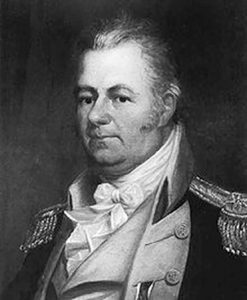
(above) Commodore Thomas Truxtun 1755 1822. One of the six appointed officers in The new US Navy by President George Washington.
He was one of the most decorated naval officers of all time and was awarded the Congressional Medal by President Thomas Jefferson in 1802. (Google Commodore Truxtun for more history.) Since that time, there has been a long line of Truxtun naval officers, as well as a continuous commission of six naval vessels named the USS Truxtun dating back to 1842. Currently in service is USS Truxtun destroyer DDG-103. http://www.public.navy.mil/surflant/ddg103/Pages/pastships.aspx. Our Thomas Truxtun is a direct descendant of the Commodore. Destined to follow in the family vocation, Truxtun was accepted to and attended the United States Naval Academy in Annapolis, MD. To everyone’s disappointment, he was deemed physically unfit and forced to leave. It is stated in a biography that this would have defeated a lesser man. Not Thomas Truxtun. Just two years later, upon rebuilding his body, he applied for and was accepted at the United States Military Academy at West Point. Showing himself to be far from physically disabled, he joined and made the plebe teams in soccer and lacrosse, starting in both sports all four years there. He was the first cadet ever to be named a three-time All-American in lacrosse, and led his team as captain in his senior year to an unprecedented record of 24-3-1. Special note is made by West Point that he settled the score for being asked to leave the Naval Academy by beating arch rival Navy twice in his senior year. West Point’s lacrosse center, which houses the lacrosse team’s locker room, training facility and coaches offices, was and still is named after Thomas Truxtun. He graduated West Point in June 1937. Truxtun was posthumously inducted into the National Lacrosse Hall of Fame in 1970. Truxtun’s Cranford connection came two years after graduation when he met his love, Margery A. “Peggy” Cruikshank, while he was stationed at Ft. Bragg in North Carolina. Miss Cruikshank was the daughter of Mr. & Mrs. Edward Allen Cruikshank of 115 Holly Street, Cranford. This was their official address at the time of his death. They were married at The Trinity Episcopal Church in Cranford on August 5th 1939. Tom and Peggy had two daughters, Mary Calvert and Julia, who was born while her father was overseas. They never met. It was at Ft. Bragg that Truxtun was commissioned in Field Artillery and promoted to first lieutenant in June 1940. October of the same year he made captain and then major in May 1943. As an advanced student in Field Artillery he was promoted to lieutenant colonel before he was shipped to Hawaii and then the Philippines in December 1944. In the Philippines, Colonel Truxtun was commanding officer of the 210th Field Artillery Battalion, 33rd Infantry Division, on Luzon.
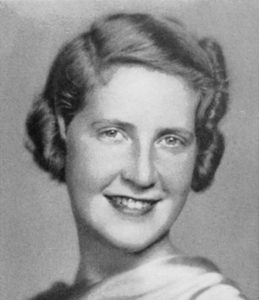
(above) Margery “Peggy” Cruikshank of 115 Holly St. Graduate of Vail-Dean School, Elizabeth, and Sweet Briar College, Va. She died 2003 at age 88. She had 12 grandchildren and 6 great-grandchildren.
While leading the battalion on the Mountain Trail near Baguio, he was observing the effectiveness of his unit’s artillery fire from an exposed position on a high vantage point, when the officer was targeted by a Japanese sniper and killed. A very unusual photograph of what seems to be a battlefield service was uncovered on Findagrave.com. It shows men of Truxtun’s battalion, still in their battle fatigues, standing at attention around his flag-draped coffin as a bugler plays Taps. At the time of his death on June 6, 1945, Truxtun had been overseas for 27 months. He was awarded the Bronze Star and Silver Star (posthumously). The esteem in which his division held Truxtun is shown by the following tribute written by his division commander: “When Colonel Truxtun first came to us, we were impressed by his fine soldierly bearing, his calm, quite, unobtrusive manner; his immediately apparent intelligence; his ready smile and ever present courtesy; his evident desire to work whole-heartedly and in earnest cooperation. These impressions, in the three years he was with us, were never changed, but were confirmed and added to. He constantly displayed a devotion to duty, professional and command abilities, tact, resourcefulness, keen intellect, judgment, and practical sense far above average. I would name him without hesitation, an outstanding officer in the 33rd Division Artillery. He was a person of unquestioned integrity, fair, honest and just in all things, open-minded, yet combined excellent force and sound balance.” “In combat Colonel Truxtun was untiring, zealous, gallant to the highest degree, careful always of the welfare of his men, careless of his own welfare provided his men were taken care of and the attack was being pushed properly.” “Officers who knew Colonel Truxtun intimately under varying conditions both good and bad have never heard him speak ill of any man. I have never heard any man speak ill of Colonel Truxtun. I think this epitomizes his character.” “He was killed in the forefront of battle, doing his job, exposing himself to see that the job was done properly.” And a West Point classmate of Truxtun wrote, “It is hard for those who knew Tom to realize that he is no longer with us, but we all feel that in his Valhalla, Tom is still Tom, ready to take the lead in any task that is required, ready to join in any quartet that needs a voice, ready to lend sympathy or encouragement to the ones who need it, in short ready to continue being the magnificent guy we all loved.” Thomas Truxtun was a great American and one of our Cranford 86.
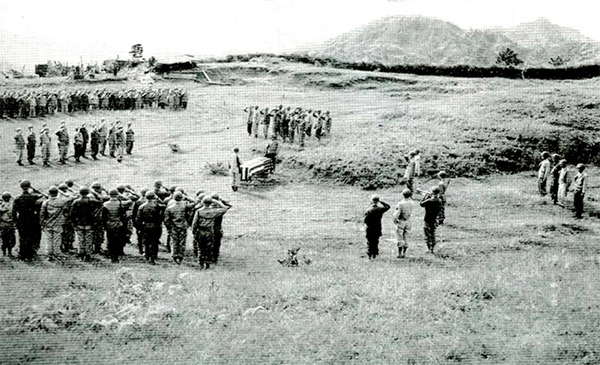
Lt. Col. Thomas Truxtun battle field funeral June 6th, 1945 Baguio, Luzon, Philippines.
